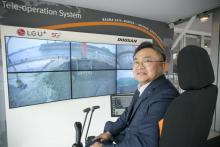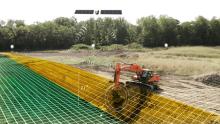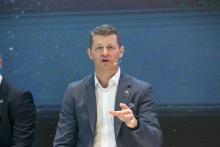Doosan Infracore brought cutting-edge remote machine control technology along with a wealth of new construction and quarrying machines to the bauma 2019 exhibition in Munich. Guy Woodford, editor of our sister title Aggregates Business, spoke to Doosan Infracore Europe CEO Charlie Park about the major global manufacturer’s event line-up and future growth strategy.
The Doosan Infracore stand was packed with visitors when I came to interview Doosan Infracore Europe CEO Charlie Park on the morning of the fourth day of bauma 2019. Park tells me it’s been the same all week as he politely poses for our Daily News cameraman who is busily taking pictures of him on and next to some of the South Korean construction, quarrying and mining equipment manufacturing giant’s new state-of-the-art loading and hauling machines.
Minutes earlier, for another Daily News photoshoot, Park had demonstrated one of the first uses globally of 5G technology to remotely control construction and quarrying machines by operating a crawler excavator in South Korea from Doosan Infracore’s (Doosan) bauma 2019 stand.
Doosan has coined the term ‘TeleOperation’ to describe the remote operation of construction equipment. It was being demonstrated during the bauma show week via the stand-based operator remote control of a DX380LC-5 40tonne crawler excavator located over 8,500km away in Incheon, South Korea.
TeleOperation has been co-developed with LG U+, the South Korean telecommunications and data services company. Doosan claims that the TeleOperation demonstration on its stand is the first to remotely control a machine across such a large distance between locations, which have a time difference of eight hours, using 5G telecommunications technology.
For TeleOperation to function properly, Park explains how it is essential to deliver live video streaming at the operator’s station in a reliable way that minimises time lag. With its ultra-reliability and low latency (signal delay), the new 5G network overcomes these issues in the Doosan system, providing 10 times faster bandwidth and 10 times lower latency than the 4G network.
After the photoshoot we decamp to an interview room on the Doosan stand, but not before Park has stressed how the manufacturer is focused on significantly increasing its wheeled loader sales to match its impressive global excavator model trading.
“We are very confident about the productivity and efficiency of our wheeled loader range. We want to change the market perception that we are far more of an excavator manufacturer, especially of mid-size and heavier-line models. Our aim is for our wheeled loaders and excavators to achieve pretty much the same sales and market share. Our Stage V wheeled loaders show real improvements on their predecessors.”
Based in Prague, Czech Republic, Park, who has been Doosan Europe CEO since May 2017, emphasises that Doosan has seen continuous growth in both its European excavator and wheeled loader sales and market share since 2012.
“Our biggest market in terms of unit sales is China, but Europe is a flagship region for Doosan. We are in a good position in Europe in terms of our distribution network and sales performance. Our growth strategy here is focused on having a more diverse product and aftermarket services offer. It’s a market where customers have different performance expectations and needs than other key world regional markets. We want to differentiate from others with our higher level of product support and services. To do that, we are creating additional product offerings and improving our servicing capability, through DoosanCare, and our replacement parts availability. Additional products will include new special application machines, like demolition excavators and material handlers, and attachment options, such as tiltrotators.”
A key European market launch for Doosan at bauma 2019 was the company’s DX800LC-5B 80tonne crawler excavator. Ideal for quarrying, mining and major infrastructure projects, the DX800LC-5B is designed to offer optimum value to the end user and, it is claimed, offers outstanding productivity, high fuel efficiency, superior operator comfort, enhanced reliability, durability and maximum uptime. The long carriage (LC) design, in combination with the undercarriage expanded to its maximum working width, offers stability and safety in all kinds of digging, lifting and loading applications.
Other key Doosan bauma 2019 launches were the 30tonne class Stage V emissions-compliant DX300LC-7 crawler excavator and the 30tonne DA30-5 and 40tonne DA45-5 articulated dump trucks (ADTs). Doosan also showcased the company's new DL280-5, DL420CVT-5 and DL580-5 wheeled loaders.
Park, who worked as Doosan Bobcat’s global chief strategy officer prior to becoming Doosan Infracore Europe CEO, tells me the new 30-38tonne -7 excavators (DX300LC-7, DX350LC-7 and DX380LC-7) will be available to European customers in the second half of 2019. “These machines are equipped with VBO (Virtual Bleed Off) technology co-developed with Bosch Rexroth which offers up to 15% more fuel efficiency than previous generation machines based on a conventional hydraulic system.”
Another eye-catching feature of Doosan’s stand was a video demonstration of Doosan Mobility Innovation’s hydrogen-powered drones for monitoring and analysing machine performance and wider operation efficiency on construction, mine and quarry sites. The DT20, for example, accurately calculates output and progress to save costs by tracking the volume of soils and minerals using aerial 3D mapping. It can also monitor and document materials, equipment and transit routes for improved operational workflow
Capable of flying up to two hours on one charge, the DT20 long-endurance fuel-cell powered drone can cover even large mining sites in a single flight, versus using multiple batteries and flight locations. Using the DT20 can also improve the safety of workers and prevent accidents by using aerial scanning rather than manual materials climbing.
“The construction and quarrying industries are changing. They are much more digitalised,” says Park. “We want to stay ahead by investing heavily in new technology for our product development, which includes investing in our drone solutions and automated machine control. We are also partnered with many big solution providers such as Trimble, Leica Geosystems and Moba (Novatron). We want to be known as the most technology-friendly brand in our markets.”
The electrification of construction and quarrying equipment was a key theme during bauma 2019. Volvo Construction Equipment (Volvo CE), for example, unveiled its first two commercial zero-emissions machines, the electric-powered ECR25 excavator and L25 wheeled loader. The unveiling came after Volvo CE had previously announced that from mid-2020 it will begin to launch a range of electric compact excavators (EC15 to EC27) and wheeled loaders (L20 to L28), simultaneously stopping new diesel engine-based developments for these models.
I ask Park whether Doosan plans to develop an electric-powered machine range. “We are developing electric mini excavators and electric large wheeled loaders. However, until we see some quite significant breakthrough in battery technology that reduces their price and increases their energy density, it will take some time until full battery-powered construction machines are embraced by the market.”
Park says Doosan is looking to stage a big demonstration later this year of its wide-ranging digital technology development for construction and quarrying machines. “It will be an event in South Korea and we are aiming to stage it in November. It will show to customers, dealers and the market in general where Doosan is going on its product development. It will include our complete suite of solutions: control centres, cloud-based systems, digitalised machines, autonomous driving and our drones.”








